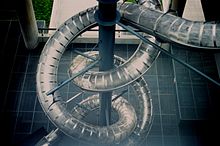- Museum of Contemporary Art, Zagreb
-
Museum of Contemporary Art Muzej suvremene umjetnosti 
Location Zagreb, Croatia Type Art museum Collection size 12,000 objects[1] Director Snježana Pintarić[2] Website www.msu.hr The Museum of Contemporary Art (Croatian: Muzej suvremene umjetnosti, often abbreviated to MSU) is a contemporary art museum located on Dubrovnik Avenue in Zagreb, Croatia. It is the biggest and most modern museum in the country.[3][4]
The museum traces its origins from the City Gallery of Contemporary Art which was established in 1954.[4] The gallery was located at the Kulmer Palace in the Upper Town area and also housed the Center for Photography, Film and Television and a museum library. Due to lack of space the museum never had a permanent display.
In 1998, a decision was made to move the museum to a brand new building on the corner of Dubrovnik and Većeslav Holjevac avenues in Novi Zagreb district. A competition for the building's design was held, and architect Igor Franić's design was chosen out of 85 entries submitted. The cornerstone for the new building was laid in November 2003, and the new museum finally opened on 11 December 2009, after six years of construction which was beset with several delays. Originally planned to cost around 200 million HRK, the cost eventually amounted to 450 million HRK (around 84 million US$), invested in equal parts by the Ministry of Culture and the City of Zagreb.[5]
The building has a total area of 14,600 m2, out of which 3,500 m2 is reserved for the permanent display and around 1,500 m2 is designated for occasional exhibitions. The building also houses a library, a multimedia hall, a bookstore, cafe and a restaurant.
The museum houses a total of 12,000 objects (of which around 600 are on permanent display)[1] and numerous works by contemporary Croatian artists, including Julije Knifer, Tošo Dabac, Ivan Kožarić, Vjenceslav Richter, Benko Horvat, Ivan Picelj, Miroslav Šutej, Tomislav Gotovac, Dalibor Martinis, Sanja Iveković; as well as international contemporary artists such as Getulio Alviani, Alberto Biasi, Max Bill, Piero Dorazio, Julio Le Parc, Richard Mortensen, Otto Piene, Jesus Raphael Soto, Victor Vasarely, Marina Abramović, Dorothy Cross, Katarzyna Kozyra, etc.
The Test Site metal sculpture by Carsten Höller was installed in the entrance hall of the museum in time for the official opening, as were installations by Braco Dimitrijević and Mirosław Bałka in front of the building's south side entrance.[7]
See also
- Modern Gallery, Zagreb
- The Strossmayer Gallery of Old Masters
- Croatian Museum of Naïve Art
References
- ^ a b Jendrić, Dorotea (12 December 2009). "Hram kulture: Umjetnička avangarda dočekala je vidjeti svoja djela u MSU" (in Croatian). Večernji list. http://www.vecernji.hr/kultura/hram-kulture-umjetnicka-avangarda-docekala-je-vidjeti-svoja-djela-msu-clanak-65912. Retrieved 4 March 2010.
- ^ "Museum Staff". msu.hr. Museum of Contemporary Art, Zagreb. http://www.msu.hr/#/en/64/. Retrieved 6 March 2010.
- ^ Mamić, Tomislav (6 October 2009). "Nakon otvaranja MSU na redu su drugi muzeji" (in Croatian). Jutarnji list. http://www.jutarnji.hr/nakon-otvaranja-msu-na-redu-su-drugi-muzeji/319782/. Retrieved 4 March 2010.
- ^ a b "MSU otvorenje: osnovne informacije" (in Croatian). msu.hr. Museum of Contemporary Art, Zagreb. http://www.msu.hr/#/hr/14391/. Retrieved 4 March 2010.
- ^ Jendrić, Dorotea (11 December 2009). "Šest godina trajao je put od kamena temeljca do novoga MSU" (in Croatian). Večernji list. http://www.vecernji.hr/kultura/sest-godina-trajao-je-put-kamena-temeljca-novoga-msu-clanak-65333. Retrieved 4 March 2010.
- ^ "Carsten Höller - Double Slide". msu.hr. Museum of Contemporary Art, Zagreb. http://www.msu.hr/#/en/14375/. Retrieved 6 March 2010.
- ^ Babić, Vanja (17 December 2009). "Prokletstvo razbijeno, nastavak slijedi" (in Croatian). Vijenac (Matica hrvatska). http://www.matica.hr/Vijenac/vijenac412.nsf/AllWebDocs/Prokletstvo_razbijeno__nastavak_slijedi. Retrieved 4 March 2010.
External links
- Official website
- Brochure with basic information about the museum in English
- Article about museum's history published in Vijenac (Croatian)
Zagreb History History of Zagreb · Gradec · Kaptol · Krvavi most · 1880 earthquake · 1995 rocket attacks · Zagreb crisis · MayorsDistricts Brezovica · Črnomerec · Donja Dubrava · Donji grad · Gornja Dubrava · Gornji grad-Medveščak · Maksimir · Novi Zagreb-istok · Novi Zagreb-zapad · Peščenica-Žitnjak · Podsljeme · Podsused-Vrapče · Sesvete · Stenjevec · Trešnjevka-jug · Trešnjevka-sjever · TrnjeBuildings and
landmarks1 Ilica Street · Ban Jelačić Square · Banski dvori · British Square · Cibona Tower · Dolac Market · Grič Cannon · Ilica Street · Jarun · Kallina House · Lotrščak Tower · Maksimir Park · Marshal Tito Square · Medvedgrad · Meštrović Pavilion · Mirogoj Cemetery · Nikola Šubić Zrinski Square · Nine Views · Old City Hall · St. Mark's Square · Tkalčićeva Street · ZagrepčankaChurches Culture Galleries and
museumsArchaeological Museum · Art Pavilion · Croatian Museum of Naïve Art · Glyptotheque · Klovićevi dvori · Mimara Museum · Modern Gallery · Museum of Broken Relationships · Museum of Contemporary Art · Strossmayer Gallery · Technical Museum · Zagreb City MuseumEducation Croatian Academy of Sciences and Arts · University of Zagreb (Academies: Dramatic Art · Fine Arts · Music · Faculties: Economics and Business · Electrical Engineering and Computing · Geodesy · Humanities and Social Sciences · Medicine · Teacher Education)Sports venues Transport Festivals Coordinates: 45°46′41″N 15°58′51″E / 45.77806°N 15.98083°E
Categories:- Buildings and structures completed in 2009
- Museums established in 1954
- Contemporary art galleries
- Art museums and galleries in Zagreb
- Novi Zagreb
Wikimedia Foundation. 2010.



